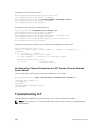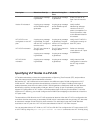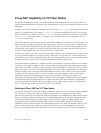
VLT LAG Mode PVLAN Mode of VLT VLAN ICL VLAN
Membership
Mac
Synchronization
Peer1 Peer2 Peer1 Peer2
- Secondary
(Community)
- Secondary
(Community)
Yes Yes
- Secondary
(Isolated)
- Secondary
(Isolated)
Yes Yes
Promiscuo
us
Trunk Primary Normal No No
Promiscuo
us
Trunk Primary Primary Yes No
Access Access Secondary
(Community)
Secondary
(Community)
Yes Yes
- Primary VLAN X - Primary VLAN X Yes Yes
Access Access Secondary
(Isolated)
Secondary
(Isolated)
Yes Yes
- Primary VLAN X - Primary VLAN X Yes Yes
Access Access Secondary
(Isolated)
Secondary
(Isolated)
No No
- Primary VLAN X - Primary VLAN Y No No
Access Access Secondary
(Community)
Secondary
(Community)
No No
- Primary VLAN Y - Primary VLAN X No No
Promiscuo
us
Access Primary Secondary No No
Trunk Access Primary/Normal Secondary No No
Configuring a VLT VLAN or LAG in a PVLAN
You can configure the VLT peers or nodes in a private VLAN (PVLAN). Because the VLT LAG interfaces are
terminated on two different nodes, PVLAN configuration of VLT VLANs and VLT LAGs are symmetrical
and identical on both the VLT peers. PVLANs provide Layer 2 isolation between ports within the same
VLAN. A PVLAN partitions a traditional VLAN into subdomains identified by a primary and secondary VLAN
pair. With VLT being a Layer 2 redundancy feature, support for configuration of VLT nodes in a PVLAN
enables Layer 2 security functionalities to be achieved. This section contains the following topics that
describe how to configure a VLT VLAN or a VLT LAG (VLTi link) and assign that VLT interface to a PVLAN.
1000
Virtual Link Trunking (VLT)


















